Final report for ONC21-089
Project Information
Affordable and effective weed-suppression strategies are critical to managing small-scale specialty crop production, especially for beginning farmers looking to scale up their operations. Additional challenges are experienced by refugee and immigrant farmers, including language barriers and a need to adapt production methods of culturally-important crops to different climates. Successful organic weed-control strategies minimize farm labor and tillage for more environmentally and economically sustainable farms. All participating farmers are co-located at an incubator farm in Southeastern Nebraska and grow similar crops across their farm businesses, catering to the Yazidi, Arabic, and Kurdish communities of Lincoln, NE. The research is a collaboration between agricultural professionals in a nonprofit (Community Crops) and land-grant university (University of Nebraska-Lincoln) and refugee farmers from the Yazidi community. It will include translation of existing USDA-supported course materials on weed management into Arabic and the current research findings will be shared in English and Arabic, with an emphasis on reaching Midwestern farmers of Arabic-speaking backgrounds. This innovative approach makes information on sustainable agricultural practices more broadly available to refugee and immigrant farming communities.
Each year of this project partnered with Yazidi farmers to test different low-cost weed suppression strategies over two seasons in two culturally-important crops, eggplants and pickling peppers. This project helped us address the original challenge on our incubator farm of intense weed pressure due to a variety of grass species. Based on our findings upon completion of this project , we learned that geotextile mulch was the most economical and effective strategy for suppressing weeds, in combination with row cover to mitigate flea beetle pest pressure that can greatly impact plant health, and in turn, yields. Participating farmers continue to use the geotextile mulch for pickling pepper and eggplant, and have expanded this practice to other crops, including onions, garlic, and greens.
- Six farmers will receive technical assistance implementing low-cost weed suppression methods for their farms.
- Four techniques of proactive weed suppression will be tested with an emphasis on culturally-relevant crops for Middle Eastern communities in the Midwestern United States.
- Research findings on effectiveness of four weed-suppression techniques will be made publicly available in English and Arabic for two culturally-relevant crops for Middle Eastern cuisine.
- Selected educational materials for a new USDA NIFA funded course at the University of Nebraska titled, “Organic Weed Management Innovations for Specialty Crops,” will be translated into Arabic for Yazidi farmers in annual technical assistance workshops.
Cooperators
- (Educator and Researcher)
Research
Weed strategy and suppression research was designed and conducted by Dr. Sam Wortman of the University of Nebraska Lincoln, and their team. Test plots were randomly selected and assigned by the research team. Each farmer maintained four test plots, consisting of a control and experimental plot for each crop researched, Nadia F1 Eggplant and Pickling Pepper. In year one, each farmer chose which experimental weed suppression they wanted to test, with options being tine weeding, Geo-Textile fabric, straw, and wood chips. Control plots were not mulched and were hand weeded. Test plots design was standardized and based off of bed dimensions and spacing farmers were already utilizing. All test plots were 3.2 meters long and 1 meter wide. Each test plot held 16 plants with a spacing of 0.4 meters both within and between rows. Soil nutrient composition was tested prior to and planting for all plots, as well as at the end of the season. Moisture readings as well as harvest yield data was collected weekly throughout the season by the research team.
In year two, the experiment was modified to use what was learned in year 1. In year two, the use of row cover was tested in combination with geotextile mulch order to learn whether or not this improved productivity and yield. A standard treatment of geotextile fabric and no row cover was used in control plots, while a treatment of geotextile with row cover was used in experimental plots. At the end of the 2021 season, we had 2 farmer participating who graduated from the program and moved from the site, or left the program to pursue other opportunities. Due to the exit of these farmers from the Prairie Pines Training Farm, in year two we lost 2 of our original participants, but were able to add one more farmer from the Prairie Pines site, for a total of 5 participants. Across the two years, 7 farmers participated in the research, and the total number of participants is reflected in this report moving forward.
A third year of the experiment was conducted due to a no cost extension of the project. Year 2 results indicated that the geotextile continued to suppress weeds effectively, and the row cover texted increased yield in eggplant. The year two project design was repeated in year 3 due to these findings.
Overall, every mulch treatment reduced labor for farmers related to time spent managing weed pressure. From the first year of data, the research team concluded that the geo-textile fabric mulch and wood chip mulch were the most effective forms of weed control. Of these two, fabric mulch was the most cost effective choice for farmers. None of the weed suppression strategies used produced significantly different yields between the control and test method used. The research team paid special attention to nitrogen immobilization commonly experienced when using organic mulch material, and found no significant yield loss related to nitrogen immobilizations when using wood chips and straw.
Harvest yield was collected weekly in pounds during the season. For example, average marketable eggplant yield was reported as ranging from 0.1 lb to 0.6 lb per plant throughout the data collection period from July 2021 to October 2021, and this was not significantly different between control and test plots. Weed counts were also taken per week, for broadleaf and grasses. Average broadleaf count for control plots ranged between five and twenty five plants per square foot, while experimental plots ranged from zero to five. Grasses ranged from five to sixty plants per square foot in control plots, while experimental plots ranged from zero to ten.
The year two data showed us that fabric mulch continued to be a cost effective strategy for weed suppression and reduced labor in relation to time spent weeding. The addition of row cover barrier as an experimental factor showed decreased injury due to pests. Experimental plots with barriers showed increased yield in eggplant only, from 9 kilograms on average in control plots to 13 kilograms in test plots.
Year three data continued to show that geotextile fabric was an effective weed barrier. While the row cover barrier was again tested as a possible measure to increase yield due to reduced pest related injury, it did not unanimously show that this was the case. Benefits were only observed in eggplant on two farms and the small reduction in injury did not correlate with an increase in yield. While we do not have definitive answers for this, we speculate that this could be due to several factors. We had intensely windy and stormy conditions at the beginning of our season and consequent damage to row cover and plants during this time on several occasions. Additionally, the variety of eggplant used, Nadia F1, was replaced by a different variety in our third experimental year, and reduced yield could be a result of slight differences in productivity between the two. Finally, farmers in years 1 & 2 applied Spinosad or Pyrethrin to eggplant crops in addition to using row cover as a method of control against flea beetles. In year 3, while flea beetle populations were still present, farmers did not elevate their pest management tactics to include chemical controls.
A summary of big picture findings for each year of this project can be found within the charts in the following powerpoint:
SARE Partnership Project Data Summary for Community Crops
Educational & Outreach Activities
Participation Summary:
During year 1, an initial video presentation was created by Dr. Sam Wortman to educate farmers about the experiment design, mulching systems, and the effect that mulching can have on productivity and labor for farmers. This video was translated and subtitled into Arabic so that farmers could access the material. A video format was utilized due to the Covid 19 pandemic, but also created as a long-term resource from this project. The video can be found on YouTube at this link: https://www.youtube.com/watch?v=GZc01yC3ylA. Auto-translate can be used to view the video with subtitles in alternative languages.
Dr. Sam Wortman and the research team hosted an additional workshop to assist with installation of mulches and planting of test plots. Technical assistance was offered at this time to instruct farmers on how to install the different experimental mulches and utilize the tine weeder tool. This group learning opportunity and assistance was repeated in year two of the project. A project presentation was given and a poster published by the research team in December 2021 concerning the first year of this project. Data and findings from the 2022 and 2023 experiment years continue to be summarized and applied by participating farmers.
At the end of our final year, in January 2024, team member Shahab Bashar presented on this project and findings at the Great Plains Growers conference at Missouri Western University.
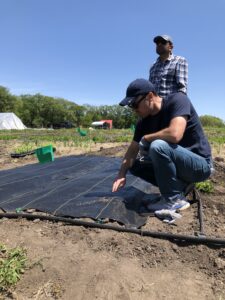
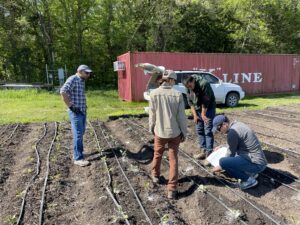
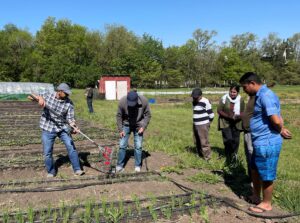
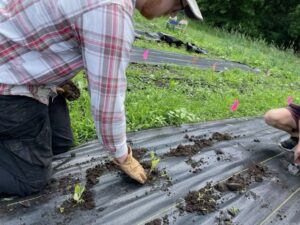
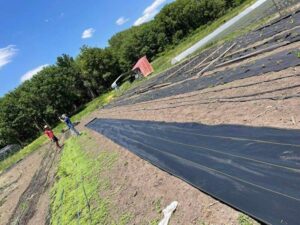
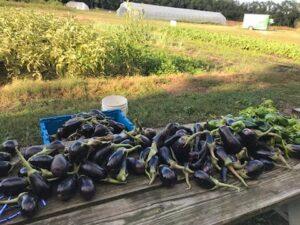
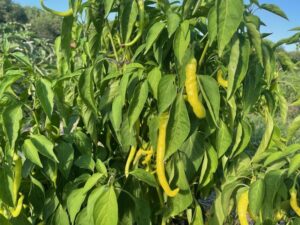
Learning Outcomes
Project Outcomes
This project has affected agricultural sustainability because it has helped us learn a way to control intense grass and weed pressure specific to our training farm site. Our farmers will continue to utilize these tools to make management decisions based on the experimental controls tested. They will also be able to budget and make smart monetary choices for their farms related to materials and labor. In year two and three of the project, we were able to reduce our use of organic chemicals used on the farm and practice our integrated pest management by incorporating row cover. We were able to see the impact of row cover protection on the survival of our tested crops within the research parameters in comparison with previous seasons in year two.
Additionally, this particular group of farmer participants supplies 7 Arabic and Yazidi markets with produce. These markets are heavily utilized by the Yazidi community, and through this project our farmers have adopted production techniques to improve their production strategies and continue to supply culturally important produce, specifically pickling pepper and eggplant, to these markets and to the broader community in an improved and more efficient way.
The Yazidi farmers have a long and intimate history with agriculture. Most are refugees originally from Northern Iraq, and come from agrarian society. Due to this, this group of farmers is well versed in how to produce specialty crops. However, when they first started farming at our training farm, they faced a learning curve related to soil type and weed pressure in particular. Weed pressure was more intense than the farmers had previously experienced. Additionally, the loamy soil, high in organic matter, produced new challenges to work with and manage. Due to participation in this study, our farmers have learned more about mulches and weed management tools that they can utilize, and what they both like and dislike about these different options. Based on the research findings from year 1, they have all begun to concentrate on utilizing geo-textile fabric as a tool to help manage the heavy grass pressure faced at the farm. In year two and three, we were able to help all participating farmers practice using row cover, so that they could experience both the benefits of weather protection and pest management on the tested crops. Participating farmers are now more confident in making informed decisions about their use of mulch and row cover in their management plans as a result of this project.